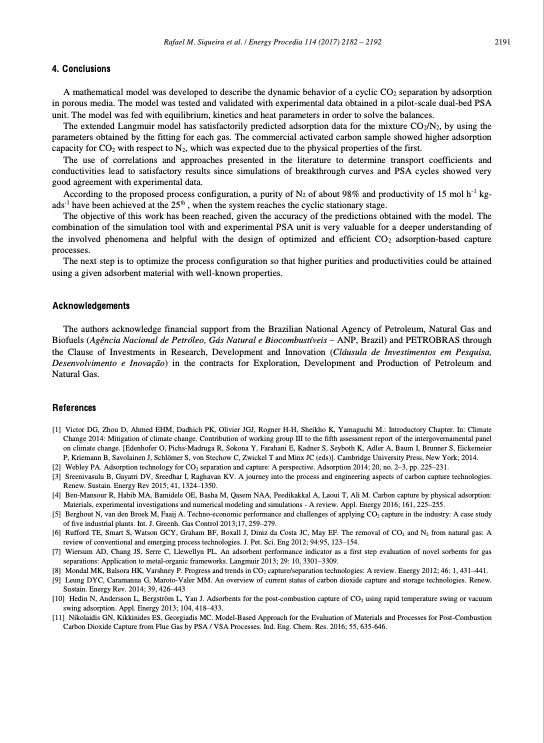
PDF Publication Title:
Text from PDF Page: 011
4. Conclusions Rafael M. Siqueira et al. / Energy Procedia 114 (2017) 2182 – 2192 2191 A mathematical model was developed to describe the dynamic behavior of a cyclic CO2 separation by adsorption in porous media. The model was tested and validated with experimental data obtained in a pilot-scale dual-bed PSA unit. The model was fed with equilibrium, kinetics and heat parameters in order to solve the balances. The extended Langmuir model has satisfactorily predicted adsorption data for the mixture CO2/N2, by using the parameters obtained by the fitting for each gas. The commercial activated carbon sample showed higher adsorption capacity for CO2 with respect to N2, which was expected due to the physical properties of the first. The use of correlations and approaches presented in the literature to determine transport coefficients and conductivities lead to satisfactory results since simulations of breakthrough curves and PSA cycles showed very good agreement with experimental data. According to the proposed process configuration, a purity of N2 of about 98% and productivity of 15 mol h-1 kg- ads-1 have been achieved at the 25th , when the system reaches the cyclic stationary stage. The objective of this work has been reached, given the accuracy of the predictions obtained with the model. The combination of the simulation tool with and experimental PSA unit is very valuable for a deeper understanding of the involved phenomena and helpful with the design of optimized and efficient CO2 adsorption-based capture processes. The next step is to optimize the process configuration so that higher purities and productivities could be attained using a given adsorbent material with well-known properties. Acknowledgements The authors acknowledge financial support from the Brazilian National Agency of Petroleum, Natural Gas and Biofuels (Agência Nacional de Petróleo, Gás Natural e Biocombustíveis – ANP, Brazil) and PETROBRAS through the Clause of Investments in Research, Development and Innovation (Cláusula de Investimentos em Pesquisa, Desenvolvimento e Inovação) in the contracts for Exploration, Development and Production of Petroleum and Natural Gas. References [1] [2] [3] [4] [5] [6] [7] [8] [9] Victor DG, Zhou D, Ahmed EHM, Dadhich PK, Olivier JGJ, Rogner H-H, Sheikho K, Yamaguchi M.: Introductory Chapter. In: Climate Change 2014: Mitigation of climate change. Contribution of working group III to the fifth assessment report of the intergovernamental panel on climate change. [Edenhofer O, Pichs-Madruga R, Sokona Y, Farahani E, Kadner S, Seyboth K, Adler A, Baum I, Brunner S, Eickemeier P, Kriemann B, Savolainen J, Schlömer S, von Stechow C, Zwickel T and Minx JC (eds)]. Cambridge University Press, New York; 2014. Webley PA. Adsorption technology for CO2 separation and capture: A perspective. Adsorption 2014; 20, no. 2–3, pp. 225–231. Sreenivasulu B, Gayatri DV, Sreedhar I, Raghavan KV. A journey into the process and engineering aspects of carbon capture technologies. Renew. Sustain. Energy Rev 2015; 41, 1324–1350. Ben-Mansour R, Habib MA, Bamidele OE, Basha M, Qasem NAA, Peedikakkal A, Laoui T, Ali M. Carbon capture by physical adsorption: Materials, experimental investigations and numerical modeling and simulations - A review. Appl. Energy 2016; 161, 225–255. Berghout N, van den Broek M, Faaij A. Techno-economic performance and challenges of applying CO2 capture in the industry: A case study of five industrial plants. Int. J. Greenh. Gas Control 2013;17, 259–279. Rufford TE, Smart S, Watson GCY, Graham BF, Boxall J, Diniz da Costa JC, May EF. The removal of CO2 and N2 from natural gas: A review of conventional and emerging process technologies. J. Pet. Sci. Eng 2012; 94:95, 123–154. Wiersum AD, Chang JS, Serre C, Llewellyn PL. An adsorbent performance indicator as a first step evaluation of novel sorbents for gas separations: Application to metal-organic frameworks. Langmuir 2013; 29: 10, 3301–3309. Mondal MK, Balsora HK, Varshney P. Progress and trends in CO2 capture/separation technologies: A review. Energy 2012; 46: 1, 431–441. Leung DYC, Caramanna G, Maroto-Valer MM. An overview of current status of carbon dioxide capture and storage technologies. Renew. Sustain. Energy Rev. 2014; 39, 426–443 [10] Hedin N, Andersson L, Bergström L, Yan J. Adsorbents for the post-combustion capture of CO2 using rapid temperature swing or vacuum swing adsorption. Appl. Energy 2013; 104, 418–433. [11] Nikolaidis GN, Kikkinides ES, Georgiadis MC. Model-Based Approach for the Evaluation of Materials and Processes for Post-Combustion Carbon Dioxide Capture from Flue Gas by PSA / VSA Processes. Ind. Eng. Chem. Res. 2016; 55, 635-646.PDF Image | Carbon Dioxide Capture by Pressure Swing Adsorption

PDF Search Title:
Carbon Dioxide Capture by Pressure Swing AdsorptionOriginal File Name Searched:
Carbondioxidecapturebypressureswingadsorption.pdfDIY PDF Search: Google It | Yahoo | Bing
CO2 Organic Rankine Cycle Experimenter Platform The supercritical CO2 phase change system is both a heat pump and organic rankine cycle which can be used for those purposes and as a supercritical extractor for advanced subcritical and supercritical extraction technology. Uses include producing nanoparticles, precious metal CO2 extraction, lithium battery recycling, and other applications... More Info
Heat Pumps CO2 ORC Heat Pump System Platform More Info
| CONTACT TEL: 608-238-6001 Email: greg@infinityturbine.com | RSS | AMP |